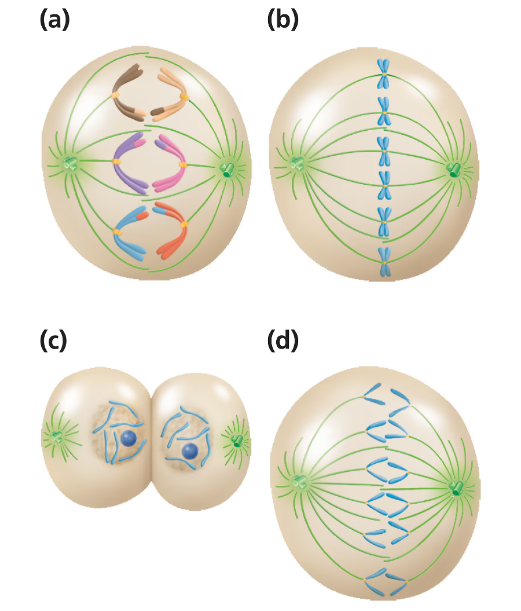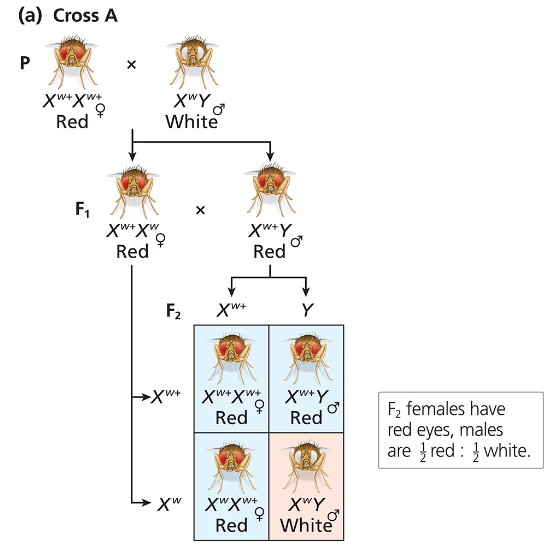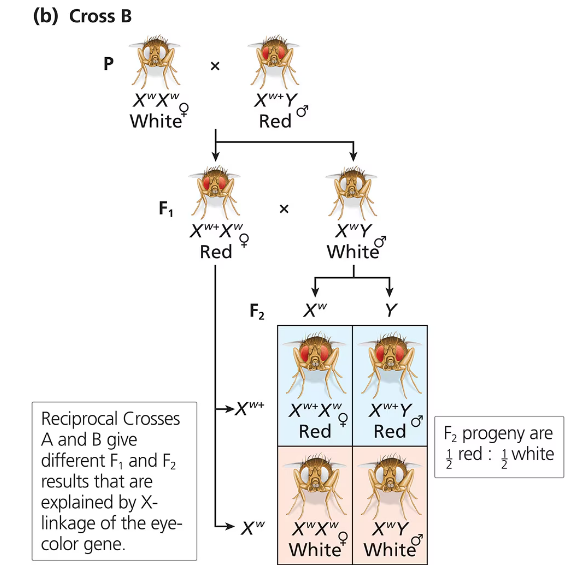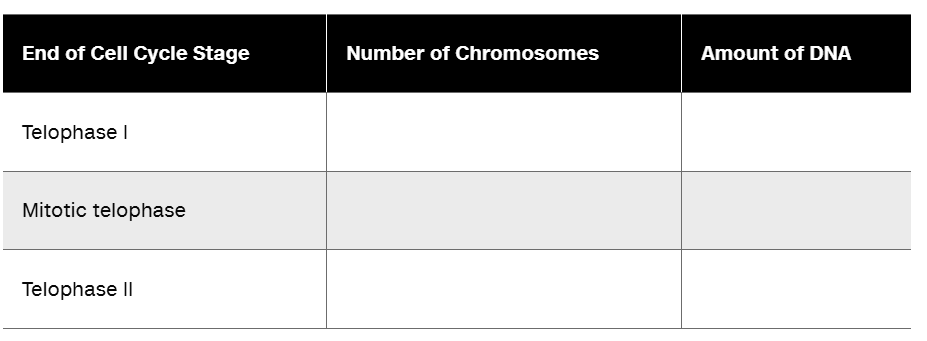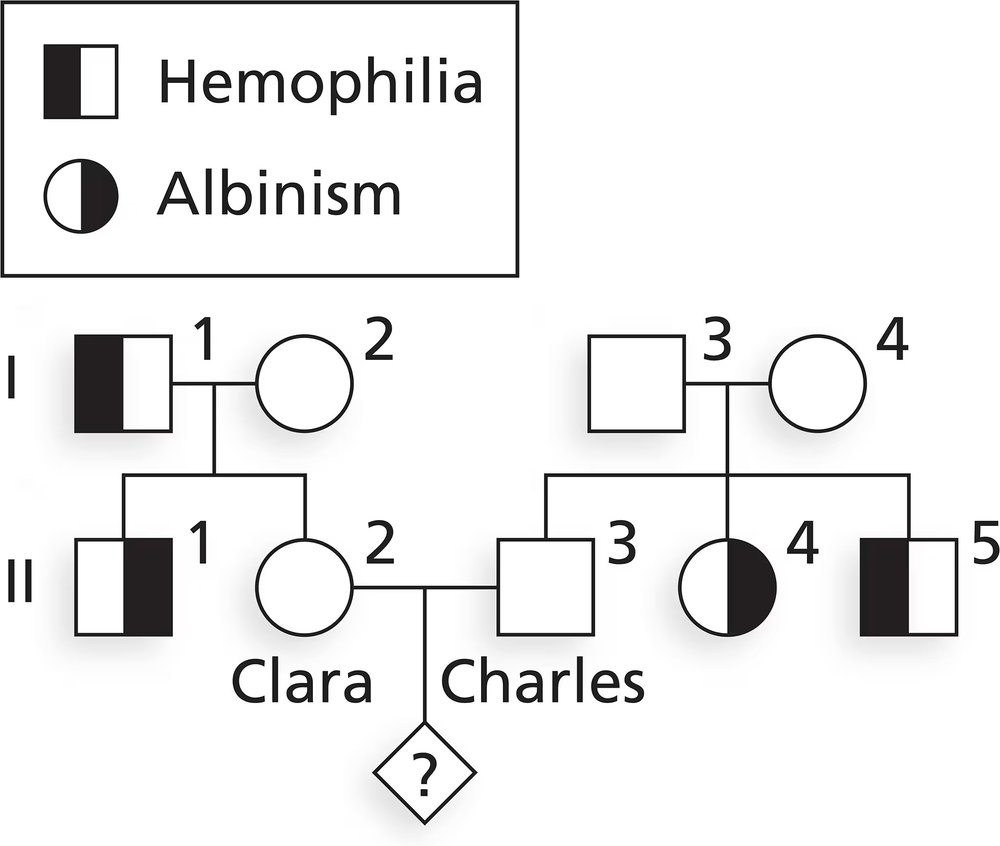 Back
BackProblem C.3c
For the retinal cancer retinoblastoma, the inheritance of one mutated copy of RB1 from one of the parents is often referred to as a mutation that produces a 'dominant predisposition to cancer.' This means that the first mutation does not produce cancer but makes it very likely that cancer will develop.
Using RB1⁺ for the normal wild-type allele and RB1⁻ for the mutant allele, identify the genotype of a cell in a retinoblastoma tumor.
Problem C.3d
For the retinal cancer retinoblastoma, the inheritance of one mutated copy of RB1 from one of the parents is often referred to as a mutation that produces a 'dominant predisposition to cancer.' This means that the first mutation does not produce cancer but makes it very likely that cancer will develop.
What is the genotype of a normal cell in the retina in a person who has sporadic retinoblastoma? What is the normal cell genotype if the person has hereditary retinoblastoma? Explain the reason for the difference between the genotypes.
Problem 32f
From a piece of blank paper, cut out three sets of four cigar-shaped structures (a total of 12 structures). These will represent chromatids. Be sure each member of a set of four chromatids has the same length and girth. In set one, label two chromatids 'A' and two chromatids 'a.' Cut each of these chromatids about halfway across near their midpoint and slide the two 'A' chromatids together at the cuts, to form a single set of attached sister chromatids. Do the same for the 'a' chromatids. In the second set of four chromatids, label two 'B' and two 'b.' Cut and slide these together as you did for the first set, joining the 'B' chromatids together and the 'b' chromatids together. Repeat this process for the third set of chromatids, labeling them as 'D' and 'd.' You now have models for three pairs of homologous chromosomes, for a total of six chromosomes. Align the chromosomes as they might appear at metaphase I of meiosis.
Problem 1
Examine the following diagrams of cells from an organism with diploid number 2n=6, and identify what stage of M phase is represented.
Problem 2a
Our closest primate relative, the chimpanzee, has a diploid number of 2n = 48. For each of the following stages of M phase, identify the number of chromosomes present in each cell.
End of mitotic telophase
Problem 2b
Our closest primate relative, the chimpanzee, has a diploid number of 2n = 48. For each of the following stages of M phase, identify the number of chromosomes present in each cell.
Meiotic metaphase I
Problem 2c
Our closest primate relative, the chimpanzee, has a diploid number of 2n = 48. For each of the following stages of M phase, identify the number of chromosomes present in each cell.
End of meiotic anaphase II
Problem 2d
Our closest primate relative, the chimpanzee, has a diploid number of 2n = 48. For each of the following stages of M phase, identify the number of chromosomes present in each cell.
Early mitotic prophase
Problem 2e
Our closest primate relative, the chimpanzee, has a diploid number of 2n = 48. For each of the following stages of M phase, identify the number of chromosomes present in each cell.
Mitotic metaphase
Problem 2f
Our closest primate relative, the chimpanzee, has a diploid number of 2n = 48. For each of the following stages of M phase, identify the number of chromosomes present in each cell.
Early prophase I
Problem 3
In a test of his chromosome theory of heredity, Morgan crossed a female Drosophila with red eyes to a male with white eyes. The females were produced from Cross A, shown in the Figure below. Predict the offspring Morgan would have expected under his hypothesis that the gene for eye color is on the X chromosome in fruit flies.
Problem 4
Cohesion between sister chromatids, as well as tension created by the pull of kinetochore microtubules, is essential to ensure efficient separation of chromatids at mitotic anaphase or in meiotic anaphase II. Explain why sister chromatid cohesion is important, and discuss the role of the proteins cohesin and separase in sister chromatid separation.
Problem 5a
The diploid number of the hypothetical animal Geneticus introductus is 2n = 36. Each diploid nucleus contains 3 ng of DNA in G₁.
What amount of DNA is contained in each nucleus at the end of the S phase?
Problem 5b
The diploid number of the hypothetical animal Geneticus introductus is 2n = 36. Each diploid nucleus contains 3 ng of DNA in G₁.
Explain why a somatic cell of Geneticus introductus has the same number of chromosomes and the same amount of DNA at the beginning of mitotic prophase as one of these cells does at the beginning of prophase I of meiosis.
Problem 5c
The diploid number of the hypothetical animal Geneticus introductus is 2n = 36. Each diploid nucleus contains 3 ng of DNA in G₁.
Complete the following table by entering the number of chromosomes and amount of DNA present per cell at the end of each stage listed.
Problem 6
An organism has alleles R₁ and R₂ on one pair of homologous chromosomes, and it has alleles T₁ and T₂ on another pair. Diagram these pairs of homologs at the end of metaphase I, the end of telophase I, and the end of telophase II, and show how meiosis in this organism produces gametes in expected Mendelian proportions. Assume no crossover between homologous chromosomes.
Problem 7
Explain how the behavior of homologous chromosomes in meiosis parallels Mendel's law of segregation for autosomal alleles D and d. During which stage of M phase do these two alleles segregate from one another?
Problem 8
Suppose crossover occurs between the homologous chromosomes in the previous problem. At what stage of M phase do alleles D and d segregate?
Problem 9
Alleles A and a are on one pair of autosomes, and alleles B and b are on a separate pair of autosomes. Does crossover between one pair of homologs affect the expected proportions of gamete genotypes? Why or why not? Does crossover between both pairs of chromosomes affect the expected gamete proportions? Why or why not?
Problem 10
How many Barr bodies are found in a normal human female nucleus? In a normal male nucleus?
Problem 11a
Describe the role of the following structures or proteins in cell division:
Microtubules
Problem 11b
Describe the role of the following structures or proteins in cell division:
Cohesin protein
Problem 11c
Describe the role of the following structures or proteins in cell division:
Kinetochores
Problem 11d
Describe the role of the following structures or proteins in cell division:
Synaptonemal complex
Problem 12a
A woman's father has ornithine transcarbamylase deficiency (OTD), an X-linked recessive disorder producing mental deterioration if not properly treated. The woman's mother is homozygous for the wild-type allele.
What is the woman's genotype? (Use D to represent the dominant allele and d to represent the recessive allele.)
Problem 12b
A woman's father has ornithine transcarbamylase deficiency (OTD), an X-linked recessive disorder producing mental deterioration if not properly treated. The woman's mother is homozygous for the wild-type allele.
If the woman has a son with a man who does not have OTD, what is the chance the son will have OTD?
Problem 12c
A woman's father has ornithine transcarbamylase deficiency (OTD), an X-linked recessive disorder producing mental deterioration if not properly treated. The woman's mother is homozygous for the wild-type allele.
If the woman has a daughter with a man who does not have OTD, what is the chance the daughter will be a heterozygous carrier of OTD? What is the chance the daughter will have OTD?
Problem 12d
A woman's father has ornithine transcarbamylase deficiency (OTD), an X-linked recessive disorder producing mental deterioration if not properly treated. The woman's mother is homozygous for the wild-type allele.
Identify a male with whom the woman could produce a daughter with OTD.
Problem 12e
A woman's father has ornithine transcarbamylase deficiency (OTD), an X-linked recessive disorder producing mental deterioration if not properly treated. The woman's mother is homozygous for the wild-type allele.
What proportion of daughters produced by the woman and the man are expected to have OTD? What proportion of sons of the woman and the man are expected to have OTD?
Problem 13a
In humans, hemophilia A (OMIM 306700) is an X-linked recessive disorder that affects the gene for factor VIII protein, which is essential for blood clotting. The dominant and recessive alleles for the factor VIII gene are represented by H and h. Albinism is an autosomal recessive condition that results from mutation of the gene producing tyrosinase, an enzyme in the melanin synthesis pathway. A and a represent the tyrosinase alleles. A healthy woman named Clara (II-2), whose father (I-1) has hemophilia and whose brother (II-1) has albinism, is married to a healthy man named Charles (II-3), whose parents are healthy. Charles's brother (II-5) has hemophilia, and his sister (II-4) has albinism. The pedigree is shown below.
What are the genotypes of the four parents (I-1 to I-4) in this pedigree?

